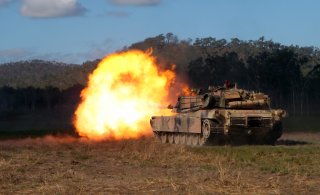The U.S. Army Wants Robot Tanks
This is the goal of the Army's Robotic Combat Vehicle (RCV), and the service has already taken the delivery of light and medium RCV prototypes from industry teams. Those test subjects will be put through the paces this year ahead of a major company-level soldier assessment in 2022, Defense News reported.
When tanks were developed more than one hundred years ago during the First World War, it was to provide a way for infantry to break through fortified positions and create a hole in the enemy lines. The early tanks employed by the British military were evolved from the landship program and featured a crew of eight or more men, but the U.S. Army is now exploring ways that tanks could be completely unmanned.
Robotic Combat Vehicle, Explained
This is the goal of the Army's Robotic Combat Vehicle (RCV), and the service has already taken the delivery of light and medium RCV prototypes from industry teams. Those test subjects will be put through the paces this year ahead of a major company-level soldier assessment in 2022, Defense News reported.
Between 2020 and 2023 the Army hopes to test three classes of RCVs. The RCV-Light should weigh around 10 tons and come armed with machine guns or rockets in the class of the Javelin anti-tank missile. The RCV-Medium should weigh around 12 tons and carry a 30-millimeter cannon or similar weapons, essentially matching the armament of a manned M-2 infantry fighting vehicle; while the RCV-Heavy would be a robotic tank that weighs around 20 tons and armed with a 120-millimeter main gun.
Last year, the Army selected QinetiQ North American and Pratt Miller to build four RCV-L prototypes, while Textron was picked to develop four medium RCVs.
Charge of the Light RCV
The first of four RCV-light vehicles were provided by the QinetiQ NA/ Pratt Miller team, which had won the contract to produce the prototypes last year. The light model reportedly weighs less than 8,500 pounds, while it is powered by a diesel-electric hybrid system and can travel at a speed of up to 40 miles per hour.
During the Association of the U.S. Army’s Global Force Next virtual symposium on March 16, Alfred Grein, acting director and deputy executive director of Ground Combat Systems at the Army Combat Capabilities Development Command, said that efforts are now underway at the center to equip the RCV-L units with government-developed autonomy software called Robotic Technology Kernel.
Following a functional checkout of the platforms, each of the prototypes was sent to Texas A&M University's Rellis campus in February. There the robotic tanks were paired with a Mission Enabling Technology Demonstrator (MET-D vehicle) to begin the manned-unmanned teaming process, Grein explained.
Medium RCV on the Way
The Army is expecting to receive the RCV-Medium prototypes from a Textron, Howe & Howe and FLIR team beginning at the end of April and continuing through early May. The service already took early delivery of a partially completed RCV-M in mid-February to begin integration of the RTK software.
The RCV-M is also a diesel-electric hybrid, and it has a gross vehicle weight of 25,000 pounds. It is equipped with a remotely operated 30mm cannon and has a top speed of over 25 miles per hour.
The Army already conducted the first of its RCV assessments at Fort Carson, Colorado last year. During those tests it focused on heavy vehicles and used surrogates, but according to Defense News, it is now preparing to conduct another soldier operational experiment at Fort Hood, Texas, from June through August of 2022 with its chosen prototypes for the RCV-L and RCV-M.
Additionally, the RCV-L and RCV-M prototypes will go through shakedown testing at Camp Grayling, Michigan, from April through September.
Ripsaw M5
Textron has already developed its Ripsaw M5, an unmanned, multi-mission RCV that has gone through several prototypes and is currently in its fifth-generation. It is manufactured in two variants, a 7.5 ton light variant, as well as a larger 10.5 medium variant. Both the light and medium variants can be equipped with conventional diesel engines, or with a hybrid electric drivetrain.
The company touts the Ripsaw as a multi-mission, multi-domain platform, capable of performing a variety of missions, including breaching/mine clearing, reconnaissance and surveillance, as well as direct-action missions. To those ends, it can be equipped with a heavy machine gun remote weapon station, a turret for a medium caliber cannon, or anti-aircraft missiles. Armor, suspension, and drivetrain are modular, and can be customized to mission requirements.
Peter Suciu is a Michigan-based writer who has contributed to more than four dozen magazines, newspapers and websites. He regularly writes about military small arms, and is the author of several books on military headgear including A Gallery of Military Headdress, which is available on Amazon.com.

